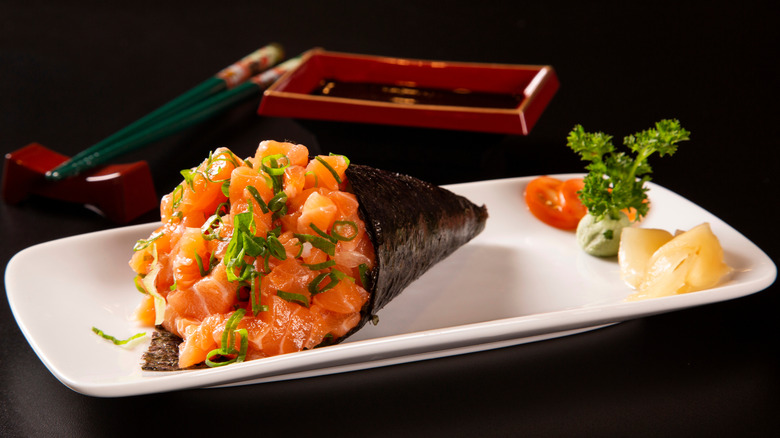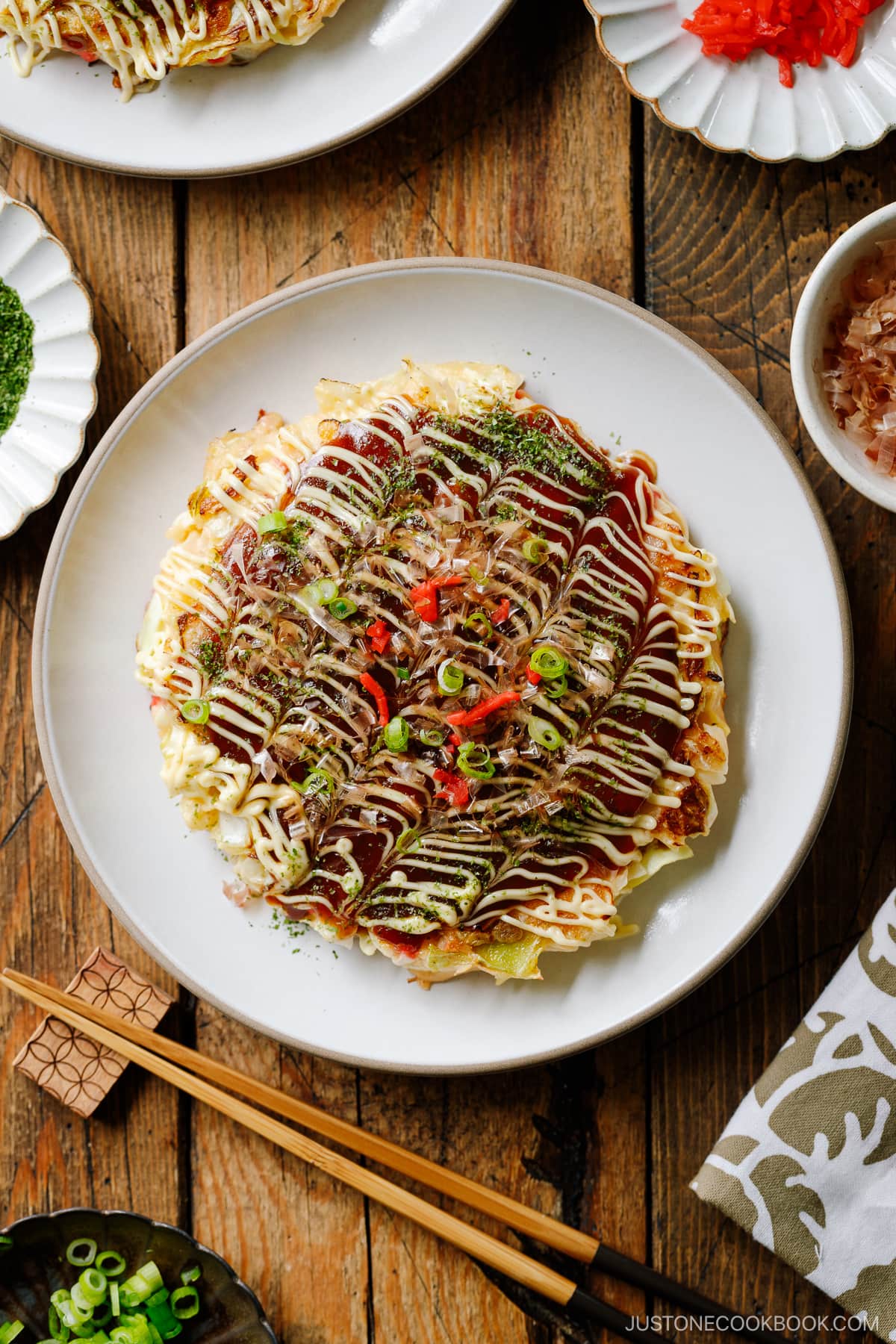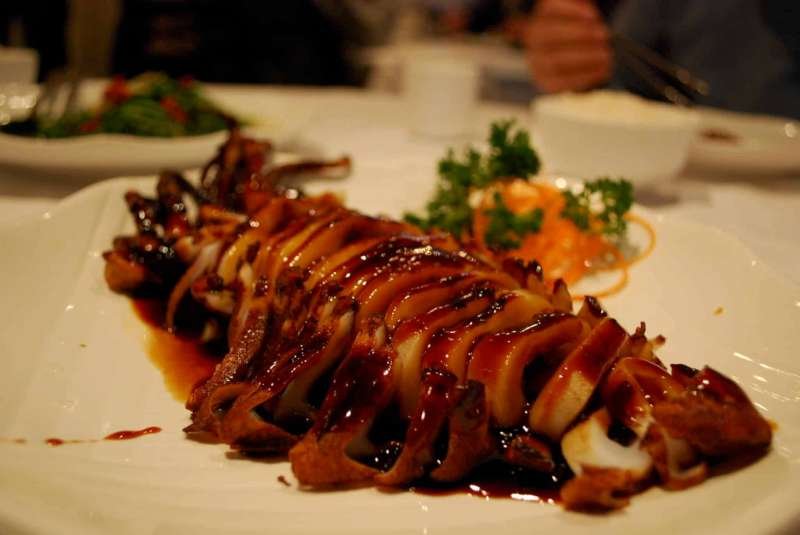Sushi!! (すし/寿司). You may think I'm going crazy. "I go into a restaurant to eat sushi; that's not street food." But at one
point, it was.
To preserve fish, Southeast Asian rice farmers in about 400 BC stuffed them with cooked rice and let them ferment about a year. Initially, they just threw out the rice and ate only the fish,
but then as the idea spread into Japan, the people there figured "Why not eat the rice as well? It lends a nice…uh, sour taste to the fish." (Don't
blame me if you're confused why you'd deliberately want to eat something sour, that's just what the source says!) This was the earliest type of sushi, known as
narezushi. (Sushi, by the way, means
sour rice.) Then around the 1600s, the fermentation process was sped up with vinegar
and at this point curing was cut down to a number of days. Sugar and salt were also added to the rice. Then, this quick fish dish—say that 5 times fast–became popular in Tokyo (historically called
Edo until the emperor moved the capital there from Kyoto, another large city, in 1868. Toukyou とうきょう/東京 means "eastern capital"
5) as fast food.
Then nigirizushi was invented in the early 1800s. A slice of fish over hand-packed rice, it was a nice portable munchie. As time went on, more fillings were added in, like ocean fish, and sushi became a little more luxurious.
Then after WWII, sushi decided to roll indoors. Everything seemed all right, but then a bone-chilling wind blew in from the east. A refrigerated wind. Never mind, no worries, this is a good thing actually! It makes the sushi last longer, and now
people were able to can serve raw fish. Sushi came to America early in its history, but really hit its swing there with Noritoshi Kanai's Kawafuku restaurant in '66, which first introduced it to diners.
Americans have kind of gotten sushi upside down and backwards. The California roll, a fusion of imitation crab meat, avocado and cream cheese, is a concoction completely different from traditional sushi. And no one's
quite sure who invented it.
A Tale of Three Tales. Who Created It?6
| Claimant |
Location |
Restaurant |
More |
| Ichiro Mashita |
Los Angeles, CA |
Tokyo Kaikan |
Avocado replaces fatty tuna and crab (later cheapened to imitation crab only) is added for a nice seafood flavor. |
| Ken Seusa |
Los Angeles, CA (Tokyo, Japan) |
Kin Jo (Fuzushi Rop-pongi) |
Once a sushi chef at the famous Rop-Pongi in Tokyo, he was a mad scientist with his flavor choices. |
| Hidekazu Tojo |
Vancouver, Canada |
Tojo's Restaurant |
Dungeness crab, avacado, spinach, egg, and sesame seeds were the original ingredients in this version of the famous roll, served uramaki
so Canadian customers would not be grossed out by seaweed. First called the Inside-Out Roll, now the Tojo Maki.
|
There are a lot of different types
7. To make things a little more interesting for you readers, let's have them be listed from "most like traditional American sushi" to "what is this???".
| Romanized name (English script) |
Literal meaning |
Japanese name (Hiragana/+Kanji) |
What is it exactly? |
I need a visual! |
| Uramaki |
Inside-out roll |
うらまき/裏巻き |
The type of sushi you know and love. That is, if you have any taste (buds) 😉. Has the rice on the outside, seaweed hidden on the inside, which is the opposite of how it's "supposed" to go.
That's right. Sushi usually has seaweed on the outside! |
You can probably imagine what this looks like. |
| Nigiri |
Two fingers (i.e. length) |
にぎり/握り |
Not to be confused with onigiri aka musubi. Those are stuffed rice balls, and I'll actually talk about them later. Instead, this is a little rice patty with wasabi covered in a slice of fish and sometimes bound together with nori. A bite-sized snack!
Did you know? Most Japanese people eat sushi with their hands and in one bite—that is perfectly okay!11 |
You can probably imagine what this looks like. |
| Sashimi |
Pierced…body? 😱 |
さしみ/刺身 |
Someone forgot to put any rice on this nigiri. Just fish. |
You can probably imagine what this looks like. |
| Norimaki/more specifically makizushi |
Seaweed roll/rolled sushi |
のりまき/海苔巻き, まきずし/巻き寿司 |
The OG? sushi, seaweed on the outside,
rice on the inside. |
You can probably imagine what this looks like. |
| Hakozushi |
Box sushi |
はこずし/箱寿司 |
This sushi is squishi! Ingredients are pressed into a rectangular shape. |
You can probably imagine what this looks like. |
| Temaki |
Hand roll |
てまき/手巻 |
A big, handheld cone-shaped foodstuff with sushi-stuff inside and nori outside. |
 19 19 |
| Chirashizushi |
Scattered sushi |
ちらしずし/ちらし寿司 |
It's sushi if you made it, well, not a roll, and put all the ingredients in a bowl instead. |
 8 8 |
Green: You've probably seen this before
Yellow: Well, this is interesting
Pink: Definitely not a California roll
Bento
Seafood can figure prominently in another popular Japanese food you've probably heard of, bento (
bentou, べんとう, 弁当; etym. from Mandarin
biàndāng, 便当, convenient).
Bento is used to refer to both specialized Japanese lunch containers and the meals within them.
Such meals center around a grain (rice/noodles) and some proteins (fish/meat/eggs), and it's not rare to get that protein through sushi. There are also veggies and fruit. I could write a whole other webpage with the amount of information
I've found on bento, but suffice it to say there are many styles, like
kyaraben (キャラべん/キャラ弁), "character bento" that play on pop culture references;
oekakiben (おえかきべん/お絵描き弁) that "paint" pictures using the food,
aisai bentou (あいさいべんとう/愛妻弁当) specially designed for loved ones, or even
shiekashiben (しえかしべん/紫衣歌詞弁) that you can make for people you're mad at, deliberately designed to gross people out or taste bad! I wonder,
is that last one best served cold?
12
 19
19 8
8

